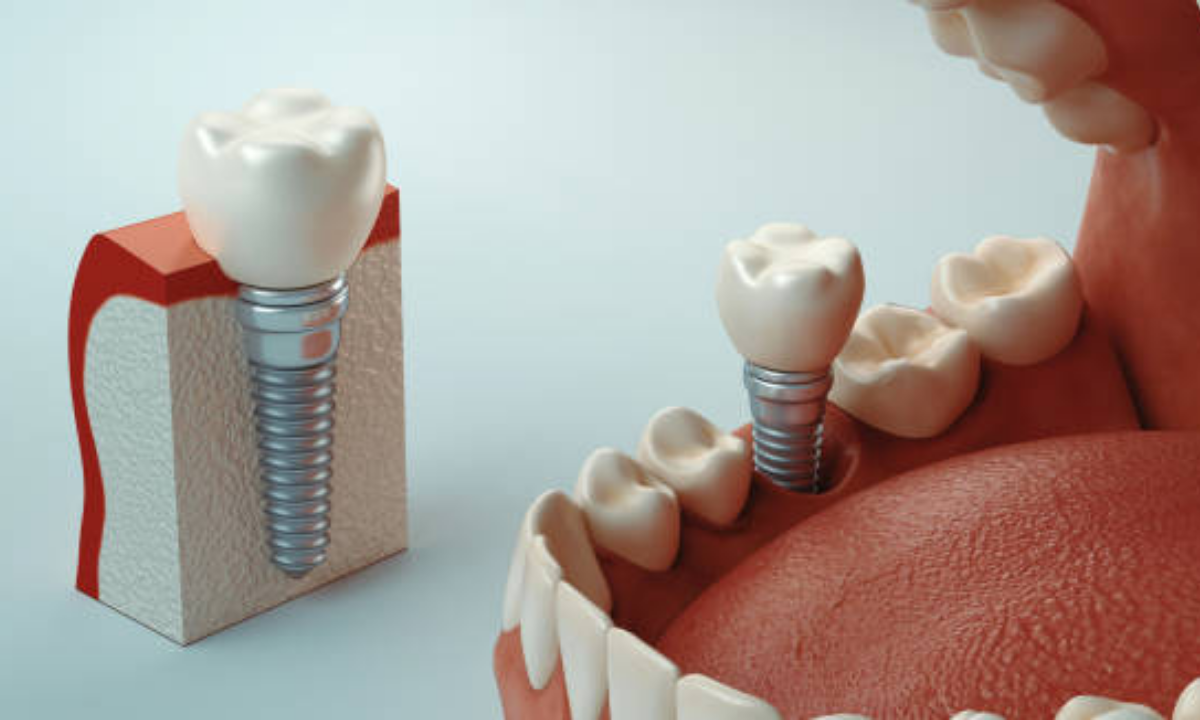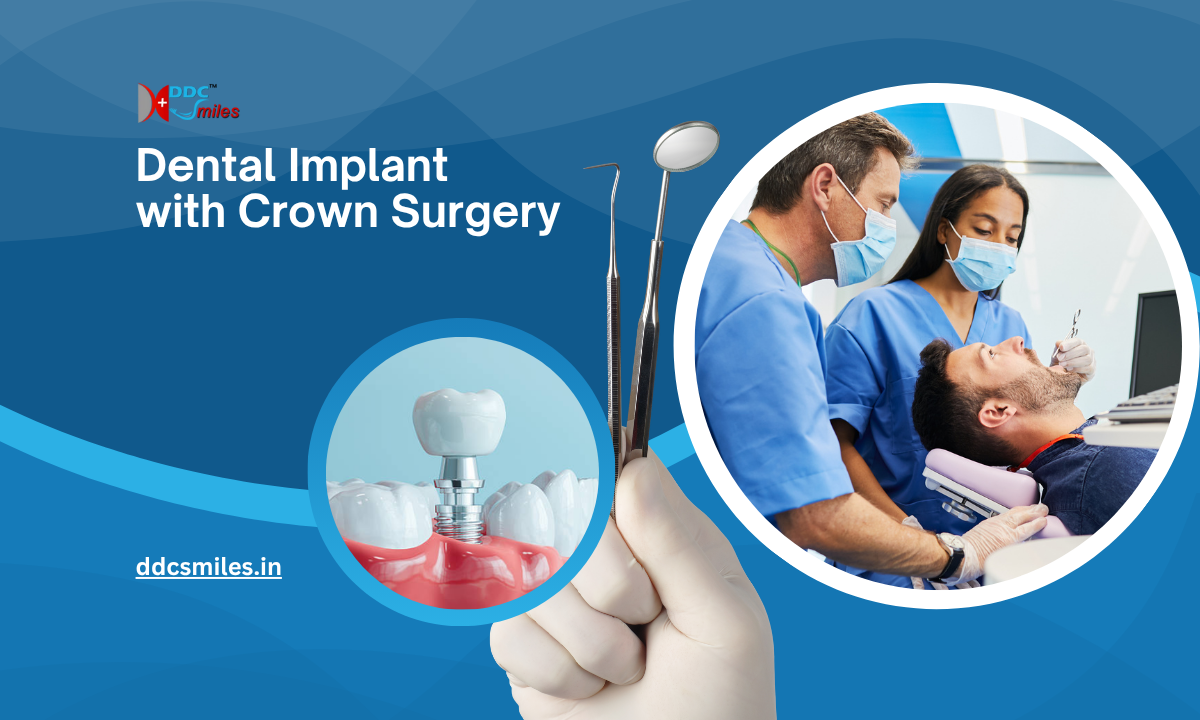When a patient comes to DDC Smiles and asks about “dental implant with crown”, I always begin by explaining why this treatment is more than just replacing a missing tooth. For me, as a dentist in Koramangala and HSR Layout, it’s about restoring function, aesthetics, and confidence.
In this blog, I’ll walk you through what dental implants are, how we perform the surgery and crown placement, and why it’s often the best solution in our area for you.
What Are Dental Implants?

Dental implants are artificial tooth roots, usually made of titanium, that are surgically placed into your jawbone. Over time, they integrate (fuse) with the bone in a process called osseointegration, giving a stable base for a replacement tooth. This distinguishes them from removable dentures or bridges. Eventually, a crown is attached to the implant through an abutment. That crown acts just like your natural tooth in look and function.
When we talk about “Dental Implant with Crown”, we refer to the full system: implant, abutment, and crown together form the functional replacement.
Why Choose a Dental Implant with a Crown?
- Long-term durability: When done properly, implants can last many decades with proper care.
- Bone preservation: The dental implant stimulates your jawbone, helping prevent bone loss after a tooth is gone.
- Natural look and feel: The crown is made to match your other teeth; no one can easily tell the difference.
- Better chewing and speech: With a stable crown on an implant, you chew and speak as naturally as before.
- No impact on adjacent teeth: Unlike a bridge that may require altering neighboring teeth, an implant stands alone.
As your dentist, my aim is always to give you not just a tooth that looks good, but one that behaves like a natural tooth and integrates well into your dental arch.
What Is Dental Implantation? / Dental Implant Surgery
It’s the surgical process in which we insert an implant (the artificial root) into the jawbone.
Here is how dental implant surgery typically goes, in stages:
- Consultation & Imaging
We first evaluate your overall oral and bone health, take 3D scans (CBCT), and plan the exact location for the implant. - Tooth extraction or site preparation (if needed)
If there’s a damaged tooth present, we remove it. If bone volume is insufficient, we may perform a bone graft to augment the area. - Placement of the implant
Under sterile conditions and local anesthesia, I place the implant precisely into the jawbone. We then close the gums over or around it. - Healing / Osseointegration period
Over weeks to months, the implant fuses with your bone. During this time, we may place a temporary crown or leave the site to heal. - Uncovering and abutment placement
After enough bone integration, we expose the implant and attach an abutment (connector) that will anchor the crown. - Crown fabrication and placement
We take impressions or digital scans, fabricate a customized crown (usually porcelain, zirconia, or ceramic), and attach it, either by screw or cement. - Follow-up and maintenance
We monitor healing, check the fit, and guide you on hygiene and upkeep.
That, in essence, is the dental implants process, from the first consultation to placing your final crown.
Step-by-Step Procedure
Let me walk you through the step-by-step procedure as I would carry it out for my patients:
- We begin with medical and dental history, examining gum health, bone density, adjacent teeth, and overall oral hygiene.
- We take diagnostic scans (CBCT) and plan virtually the position and angulation of the implant.
- If the bone is not enough, we perform a bone graft. Patients wait some weeks for healing.
- At surgery, I administer local anesthesia (often with sedation if needed). I make an incision in the gum, drill into the bone gradually, and place the implant into its site.
- The incision is sutured. You go home with post-operative care instructions (antibiotics, soft diet, oral hygiene protocols).
- After healing (3–4 months typically in many cases), I expose the implant and connect the abutment.
- Impressions or scans are taken for the crown. The lab fabricates the crown to match your bite and tooth shade.
- The crown is attached (screwed or cemented). I check occlusion (bite) and adjust if needed.
- We schedule periodic check-ups, every few months or annually, depending on your case.
What are the three types of dental implants?
While classification varies, common types include:
- Endosteal implants (in the bone) – the most common
- Subperiosteal implants (on or above the bone surface)
- Zygomatic implants (anchored in the cheekbone for severe bone loss)
What Are the Types of Crowns & Implant Crown Attachments?
When we place the crown on a dental implant, there are choices:
- Screw-retained crown: The crown is fixed on the abutment via a screw. A small access hole is later filled to hide it. This design allows easier removal for maintenance if needed.
- Cement-retained crown: The crown is cemented permanently over the abutment. It offers a more aesthetic look (no visible screw hole), but removal is trickier.
- Hybrid options or custom abutments are also used depending on anatomy and esthetic demands.
The crown material is selected to mimic your natural tooth in color, shape, and strength.
Before and After: What You Can Expect
Dental implants before and after photos are powerful evidence of transformation. Before the procedure, patients may have gaps, compromised chewing function, and shifting adjacent teeth. Afterwards, you see a full, stable set of teeth with improved function and aesthetics.
We always show patients in our DDC Smiles portfolio the before and after cases so you can gauge what’s possible in your smile.
Final Thoughts
At DDC Smiles, when I advise a patient on a Dental Implant with a Crown, I do so from over a decade of experience. I’ve seen how this comprehensive solution not only restores a missing tooth but also transforms confidence, facial shape, function, and oral health.
In HSR Layout or Koramangala, when patients come to us having struggled with removable dentures or missing teeth for years, they often tell me how life changes when they bite into food, smile at photos, or speak without hesitation.
This procedure is not just mechanical; it’s deeply personal. I guide each patient step by step: assessing bone, customizing their plan, executing surgery with precision, and delivering a crown that blends naturally. I commit to follow-ups and preventive care so that your implant stays healthy for years to come.
If you’re considering Dental Implants in HSR Layout and Koramangala, I invite you to visit DDC Smiles. We are proud to be among the best dental hospital in HSR Layout and Koramangala, offering comprehensive implant dentistry by experienced surgical dentists. We tailor each treatment specifically for you, ensuring your smile is functional, beautiful, and lasting.
FAQs
1. How Long Will My Implant Last With A Crown?
If you maintain good oral hygiene, attend checkups, and avoid extreme habits (like chewing very hard objects), your implant can serve you for decades—often a lifetime.
2. Will It Be Painful?
Discomfort is minimal during surgery due to anesthesia. Postoperative soreness is manageable and short-lived with pain control and care.
3. Is A Tooth Implant Good Or Bad?
It’s one of the best options when you want a fixed, durable, natural-feeling tooth replacement. Like any medical procedure, success rests on planning and execution.
4. What Types Of Implants Exist?
The main categories are endosteal, subperiosteal, and zygomatic implants, chosen based on bone condition and treatment needs.




